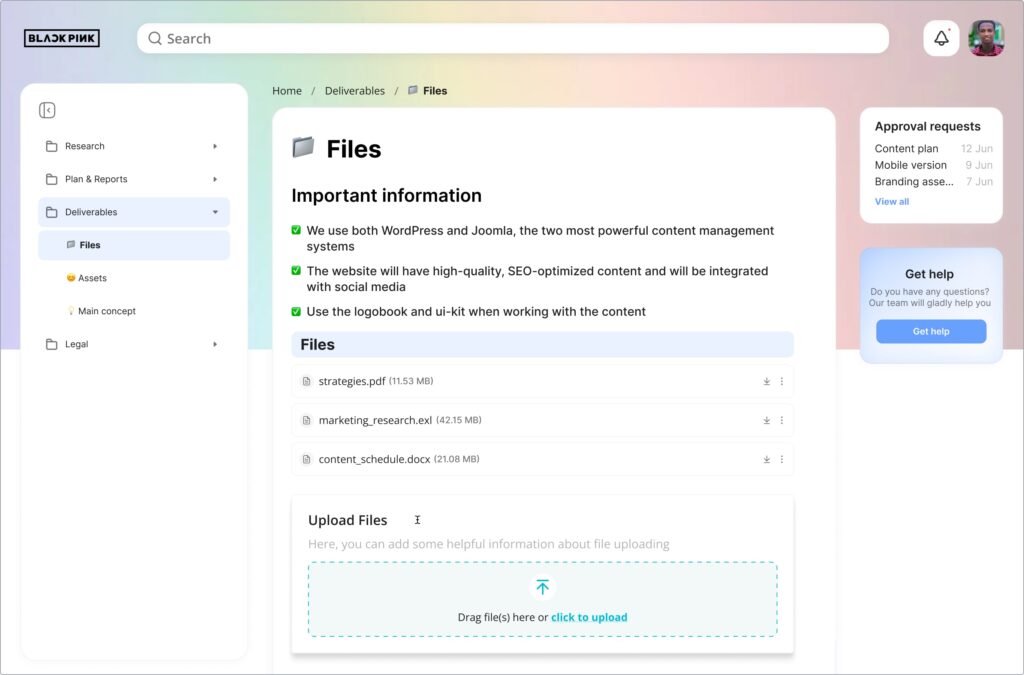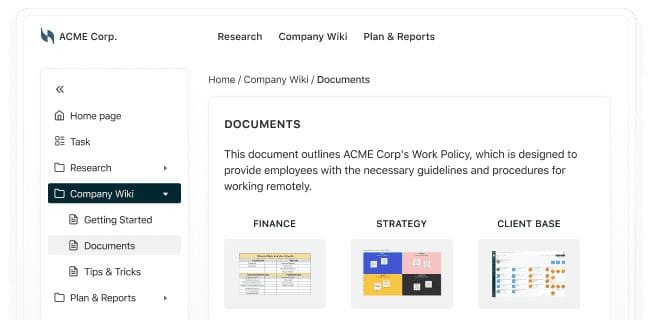
A Comprehensive Guide to Knowledge Sharing in the Workplace
- December 26, 2022
- 12 Min read
Two heads are better than one. This wise, old saying rings particularly true in today’s business world, where collaboration and communication are crucial to achieve growth and success. And this is where knowledge sharing comes in.
Knowledge sharing is an essential part of making a business successful; it encourages coordination, boosts morale, and helps teams to stay on top of their industry. By understanding and practicing effective knowledge sharing, companies can unlock their team members’ potential and increase productivity and growth, especially when remote work is present. Who wouldn’t want that, right?
And that’s why we’re writing this article; to help you understand what knowledge sharing is in a business setting, its importance within the workplace and how to overcome knowledge barriers.
What is Knowledge Sharing?
Knowledge sharing is the process of exchanging and distributing information, ideas, and insights among members of an organization. This exchange of information is key for any organization to function efficiently and effectively, and it is a so-called knowledge management process.
A knowledge sharing culture helps members to share best practices, solve challenges together, improve team member coordination, and it can be done in many different ways, such as through conversation, encouraging collaboration, or the use of technology.
Just imagine a team where each of the members is great at something but clueless about other things. If employees are encouraged to share their knowledge and skills with each other, they can all become better and they won’t directly depend on each other as much. Just think how much easier it would be if web developers knew a bit of SEO!
It is also an invaluable tool for organizations to develop creative ideas, identify opportunities, and drive innovation. When knowledge sharing takes place, it is easier for members to make well-informed decisions that are beneficial to the organization’s success.
So remember this, sharing is caring!

Types of Knowledge
Within the knowledge management process, we can refer to two main types of knowledge, depending on its nature and how knowledge sharing happens. So let’s take a look at them.
Explicit Knowledge
Explicit knowledge is the type of knowledge that is codified and can be written down in documents, books, articles, and other forms of media. It usually responds to What is…? and it’s the type of knowledge that we traditionally think of when discussing the term knowledge. It is easily shareable and can be used to educate and inform large numbers of people.
This type of knowledge is often used to create training materials, manuals, textbooks, and other documents. It can also be used to create databases, websites, and other digital resources.
The importance of this kind of knowledge is that it is easily documented and can be relied upon for accuracy.
Tacit Knowledge
Tacit knowledge is knowledge that is typically acquired through experience, intuition, and trial and error. It is usually difficult to explain, and often not deliberately shared.
Tacit knowledge is often referred to as know-how or know-why. It often involves complex processes, such as problem-solving, decision-making, and the understanding of relationships between different elements or combinations of elements.
Examples of tacit knowledge include understanding how to interact with people and how different situations should be handled, or knowing when to speak in a meeting or how to write an email and phrase your sentences to achieve the desired result.
While it can also be documented to some extent, the best way to share tacit knowledge is through collaboration, training and mentorship.
And now that we’re familiar with the culture of knowledge sharing and the different types of knowledge, let’s take a look at the main benefits within the workplace.
Why is Knowledge Sharing Important in the Workplace?
The benefits of knowledge sharing are incalculable, but we’ve narrowed them down to ten, because we care about you and, let’s be honest, because ten is a nice round number.
- Teamwork and coordination: By ensuring effective knowledge sharing, employees can work together and collaborate more seamlessly and efficiently, without depending on each other all the time. This benefit, as we already know, improves team coordination.
- Problem-solving and decision-making: As the wise Abu Bakr said, “without knowledge, action is useless, and knowledge without action is futile”, which is why sharing and preserving collective knowledge is so crucial in the workplace.By accessing a wider range of information and perspectives, employees can come up with better solutions to challenges and make more informed decisions. It is important to highlight here the need for a central information hub or wiki where information and processes are stored. For that, we recommend using some of the best knowledge base software.
- Innovation and creativity: Knowledge sharing can spark new ideas and approaches that can lead to new products, services, and processes. You don’t want your business to become stagnant and give in to the competition, right? Right. So make sure to foster innovation and creativity. Your organization will enjoy the benefits!
- Job satisfaction and motivation: If your employees feel that their knowledge and expertise are valued and used within your organization, and they can actually see the results of sharing knowledge, they are more likely to feel engaged and motivated. This is especially true of Millennials and Gen-Z workers. This, in return, will lead to a much lower employee turnover, which is always a positive thing for any company in the long run.
- Communication: As a result of knowledge sharing, team members can communicate with one another more effectively and ensure that key information is not lost.
- Company skills: When knowledge is shared effectively between team members and across departments, everyone can learn from one another and every employee can improve their own skills thanks to the knowledge and know-how shared by others.
- Quality of products and services: Every business has customers to keep happy and products or services to sell. When a company’s internal knowledge is rich and shared among its employees, it is much easier to improve products and services, and make them of the highest quality. Hell yeah!
- Organizational efficiency: When knowledge is shared and easily accessible by means of a knowledge base or wiki, we will avoid wasting time and effort while doing our jobs, and we will ensure that the organization is using its resources effectively. This is critical for companies which have established or plan to establish a remote work culture.
- Competitive advantage: When employees have access to a wealth of knowledge and information, they can do their jobs faster and please customers better. This can lead to improved productivity, higher-quality work, and a stronger competitive position in the market. To put it simply, knowledge sharing can help the organization stay ahead of the competition and stay innovative.
- Company success: And finally, all the previous reasons to share knowledge amount to this final one, the holy grail of the business world: success. It’s as simple as that, knowledge sharing can actively contribute to achieving a company’s goals and objectives. And that’s what it’s all about, isn’t it?
Common Knowledge Sharing Barriers in the Workplace
There are many potential barriers to knowledge sharing in the workplace. But some of the most common and serious barriers include the following:
- Knowledge silos: A knowledge silo is a barrier, figuratively speaking, that prevents the free and open flow of information between people and departments, leading to inefficiencies and a lack of coordination. This tends to happen when teams or departments work in isolation rather than as part of a larger picture, hindering overall growth and team coordination.
- Lack of time: If your employees are snowed under, stressed out of their minds and barely have time to breathe or go to the toilet during work hours, they will certainly not have time (or energy!) to share their knowledge. This seems obvious, but it is sometimes overlooked by team managers.
- Lack of trust: Employees may be hesitant to participate in knowledge sharing if they do not trust their colleagues or the organization. This tends to happen when employees are motivated or pushed to perform through competition. While healthy competition is usually positive for growth, too much of it can lead to distrust and can affect coordination and knowledge sharing.
- Fear of failure: The members of a team might feel reluctant to open up and take part in knowledge sharing processes with others if they do not feel confident in their value. They may fear being judged or criticized for sharing their ideas, and this fear can be a major impediment to productivity and coordination.
- Lack of motivation: Employees may not feel motivated to share their ideas if they do not believe that it will be appreciated or utilized. Without positive reinforcement, some people may not recognize the value in sharing their insights or providing feedback.
- Lack of incentives: In a similar way, a company’s team members may not be motivated to share their knowledge and ideas if there are no rewards or recognition for doing so. Without any incentive, employees may be less likely to participate in brainstorming sessions or actively contribute to team projects.
- Organizational culture: The culture of an organization can either encourage or discourage knowledge sharing. If the culture is hierarchical or competitive, employees may not want to share their knowledge and ideas or simply feel that it is unnecessary.
- Technology barriers: If an organization does not have the right technology or systems in place, it can be difficult for em,ployees to share their knowledge and ideas effectively. For this reason, we recommend using FuseBase (formerly Nimbbus), which has all the necessary tools to tear down the technology barriers to share and retain knowledge efficiently.
- Communication barriers: When team members lack the necessary communication tools and skills for sharing knowledge, it can be difficult for them to effectively convey their ideas to their colleagues and managers.
- Knowledge gaps: If a worker does not have the right knowledge or expertise, they may hesitate to share what they do know, simply for fear of being seen as inadequate.
- Language barriers: If the members of an organization speak different languages or use different terminology, it can be difficult for them to understand and share knowledge with one another. This can happen especially in large international corporations that work across borders.
If you really want to foster a collaborative environment in the workplace, it is key to break down these barriers to knowledge sharing and work on a workplace culture that motivates and allows teams to share and create collective knowledge.
Top 7 Strategies to Encourage Knowledge Sharing
1. Encourage team members actively to share knowledge and expertise, learning with and from each other. Take advantage of subject matter experts in your organization by encouraging them to teach others. This could include internal mentoring and training sessions, presenting at conferences or workshops, and sharing case studies, best practices, or other examples of success or failure.
2. Use technology to facilitate knowledge sharing. This could include tools such as collaboration software, knowledge management systems, or social media platforms.
3. Recognize and reward those who share their knowledge and expertise with others. This could include public recognition, awards, or other forms of recognition. Heck, you can even issue Amazon gift cards!

4. Create a culture of learning, knowledge sharing and continuous improvement. Encourage your employees to seek out new information, connect ideas and insights, and to share them with others. Provide training and development opportunities to help employees improve their knowledge management and skills in the form of workshops, seminars, or courses.
5. Provide opportunities to network and connect with others outside the workplace. This could include social events, networking groups, or other forums for knowledge sharing.
6. Encourage open and transparent communication. Encourage employees to share knowledge and ideas openly and honestly, and create an environment where they feel safe and comfortable to do so.
7. Be a knowledge sharing role model. As a leader, it’s critical to set an example and show your colleagues that you value the exchange of ideas and knowledge, and that you’re willing to take the lead in sharing your own expertise and experience.
In conclusion, when employees are encouraged, have the opportunity and are treated well, knowledge sharing will simply come much more easily, and it will be far more effective.
Share your Knowledge Today with FuseBase

FuseBase allows you to collect, retain and share your company’s knowledge seamlessly with its suite of tools. Create Superdocs with the Internal Workspace, where you can embed just about anything you can think of to enrich your document management and make it easier to communicate. FuseBase also comes with instant messaging and video calls, for when emails or screencasts just don’t cut it. Thanks to FuseBase, sharing knowledge and learning from each other has never been easier.
Build a complex strategy for knowledge sharing with FuseBase!
Wrapping Things Up
In conclusion, sharing knowledge in the workplace is essential for businesses to stay competitive and successful. By creating a culture of open communication, encouraging collaboration, and leveraging technology, organizations can ensure that knowledge is shared and employees are equipped with the skills, resources, and information they need to succeed. Establishing a comprehensive knowledge sharing strategy is critical for business success and should be a priority for any organization looking to build a successful future.
Find more FuseBase articles and updates on our LinkedIn page!
Found it useful? Share the article with your community
Subscribe to our blog!
Get weekly tips and insights on how to grow your business